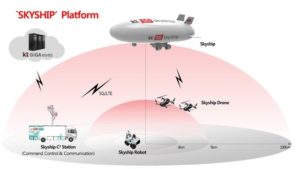
Dubbed SKYSHIP, the platform includes a helium-powered airship drone, mobile ground station, as well as installed smaller drones and robots. The airship will carry a pod filled with propellants, cameras, network modules and a scanning device which can detect smartphone signals to help identify missing people.
“Over the past years, KT has pioneered technological innovations in the field of disaster and safety management in South Korea,” said Oh Seong-Mok, president of KT’s network business. “We will continue our efforts as the ‘People’s Company’ to make the country safer and more secure with our advanced technological prowess, resources and know-how.”
During a media event last week, KT ran a disaster scenario simulating a remote search and rescue. SKYSHIP coordinated drone data with a nearby hospital and identified a “disaster survivor,” while directing rescue workers via augmented-reality eyewear.
Seong-Mok explains:
“Signal scanning by Skyscan, which uses an ultra-small LTE device, can check the presence of survivors within a 50-meter radius, thereby narrowing the search area for faster rescues. When survivors are detected, Skyship will deploy drones to pinpoint their exact locations. Robots will then be dispatched on the ground to deliver emergency relief items, relay information to rescuers and take first-aid measures until rescuers arrive.”
To develop SKYSHIP, KT collaborated with Korean drone company Metismake Inc. to develop its latest Skyship 2, an advanced version of its first Skyship introduced last year. The drone can fly up to six hours with a maximum speed of 80 kilometers per hour, withstand 13 meter-per-second winds and carry a payload of up to five kilograms.
A company release notes:
“5G’s hyper-connectivity and ultra-low latency will enable rescue and medical crews to work more effectively. For example, the 4K UHD video footage filmed by Skyship drones and robots, and transmitted through a 5G network, can enable a more accurate analysis of disaster scenarios. 5G can also improve remote control and command in real time, along with other applied services.”
Jason is a longstanding contributor to DroneLife with an avid interest in all things tech. He focuses on anti-drone technologies and the public safety sector; police, fire, and search and rescue.
Beginning his career as a journalist in 1996, Jason has since written and edited thousands of engaging news articles, blog posts, press releases and online content.
Email Jason
TWITTER:@JasonPReagan
Subscribe to DroneLife here.